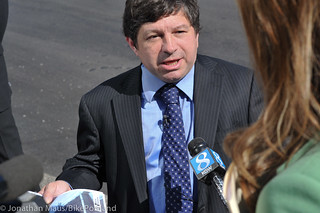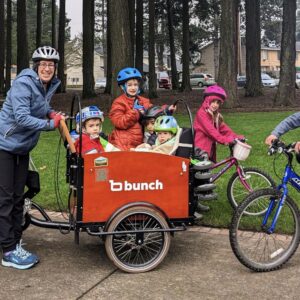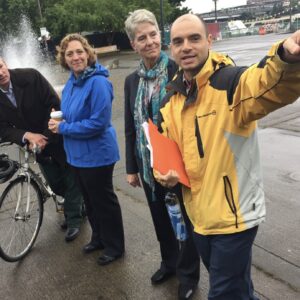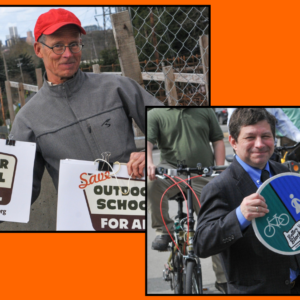Transportation Commissioner Steve Novick and PBOT Director Leah Treat want to hear from you about neighborhood transportation needs. They also wants to draw attention to existing problems they’d like to fix with your money.
Novick and Treat are in the middle of a major effort to pass a “street fee” that would raise new money for street repairs and updates. At tomorrow’s “Transportation Needs Tour” they’re inviting the news media to join them in a for a stop at three locations that’ll highlight where new revenue would be spent.
Keeping to the City’s strategy of not mentioning the “b” word (bikes); a statement released this morning about the tour specifically addresses “streets that lack sidewalks” and “commercial corridors in need of preventative maintenance.” In addition to the three stops, the City will also unveil the Portland Transportation Needs Guidebook, “an online compilation of the maintenance and safety needs identified by the Portland Bureau of Transportation and prioritized by community input over the years.”
On his own website, Novick explained more about the impetus for the tour:
“I spend a lot of time hearing about and talking about and trying to do something about the gaps in our pedestrian network; I decided it would be nice to see some of the work that the Bureau of Transportation has been able to do with the limited resources it has. While out looking at a couple of locations, some neighbors stopped me to say what a difference the safety improvement have made in the community.”
Advertisement
While he has barely mentioned bicycling or bike-related projects during his tenure as PBOT commissioner, Novick has repeatedly talked up walking projects. During press conferences and other events related to the street fee, he often recalls his experience of helping families cross a dangerous section of NE Prescott following the installation of 11 blocks of new sidewalks. Novick has also lobbied (unsuccessfully) for crossing beacons out of the City’s General Fund budget and he wrote a guest column in The Oregonian back in January titled, Portland needs more money for pedestrian safety.
The political context of this event could have something to do with the big debate over how to allocate new revenue from the proposed street fee. Novick, PBOT Director Leah Treat and Mayor Charlie Hales are hearing loud and clear from an advisory committee of business interests that most of the new revenue should be spent on paving and maintenance — not on “safety” projects.
On the recent episode of the KBOO Bike Show, Director Treat said she’s “frankly concerned about how the money is going to get split up.”
“There’s a real divide among advisory groups about how this money is spent… the business group wants all the money to be spent on maintenance and paving. They don’t necessarily believe there’s a constituency that’s concerned about safety and alternative transportation on our roads. We need our friends, activists, and concerned citizens to surround this issue. They need to be vocal.”
While Treat and Novick have made it clear they want more funding for safety projects, they’re up against not just fear-inducing business owners, but a mayor who made “getting back to basics” and “100 miles of paving” major campaign promises that he has worked hard to deliver on since taking office in January 2013.
Exactly how any new revenue is split — the ratio between maintenance and safety investments — is shaping as a key sticking point in street fee talks.
On tomorrow’s tour, Novick and Treat will be joined by neighborhood activists, PBOT staff, and members of the local media who will pile into a van and make the following stops:
- Departing Portland City Hall, SW Fifth Ave. entrance at 9:30 a.m.
- 10 a.m. Tour begins at SE 130th Ave. and Salmon Street, at a crosswalk near David Douglas High School ball fields
- 10:45 a.m. Tour begins at SE Hawthorne Blvd. and 36th Ave., north side of the intersection.
- 11:45 a.m. Tour begins at SW Capitol Highway and Garden Home, at the bus stop on the east side of Capitol Highway.
- Expected return to City Hall at 1 p.m.
While I think doing the tour by bike would be a much more effective way to learn about our city’s transportation needs, I went ahead and requested a spot in the van. If I get in, stay tuned for more coverage of the event both here on the Front Page and via Twitter.






Thanks for reading.
BikePortland has served this community with independent community journalism since 2005. We rely on subscriptions from readers like you to survive. Your financial support is vital in keeping this valuable resource alive and well.
Please subscribe today to strengthen and expand our work.
I am really uncomfortable splitting this field up into asphalt + safety, as if this was even close to adequately capturing the situation we’re facing in funding our transportation infrastructure. Besides, even if the damned Street Fee somehow gets past all the objections, the amount so raised is going to be paltry compared to what everyone agrees is the size of the hole we’re already in. Let’s get this right and create something that will work for the short and medium term. Gas tax indexed to 3x inflation would be my start.
As for the long term, let’s not even go there.
Need to switch to a mileage weight tax.
does this accomplish something a worth-it’s-name gas tax doesn’t?
People mention wonky workarounds like this all the time but I can’t get anyone to explain much less convince me that these ideas have anything on the version we already know and that works the world over.
As fuel efficiency increases, gas tax revenue goes down for the same amount of vehicle use. A weight-mile tax stabilizes that revenue stream.
Gas efficiency on a whole hasn’t changed much for many decades. Only on the stickers plastered on the windows of new cars. Those numbers are based on a single test car, usually the prototype. If two models are close in design the manufacturers don’t have to test the near copy models (think Toyota and Lexus), they can simply use the same numbers from the one prototype.
The prototypes which are tested are usually significantly different than the car being sold, they are usually manufactured with better parts and with tighter manufacturing standards than the models on the showroom floor. Needless to say, some prototypes might have some fairly dramatic differences than their showroom counterpart because changes are made to low costs for the sale models.
Toss in other variables like maintenance issues, tire pressure, road conditions and driving technique (the one that effects the MPG the most) you are typically looking at getting 25% less MPG than the sticker boasts. Which puts most vehicles sold in the roughly 20 -25 MPG category, which is about the same of a Model T.
The whole MPG thing has actually been in the news cycle of in the automobile world lately, I’m pretty sure there have are a few lawsuits in the pipeline over this issue.
Oddly enough I think I have gotten OVER the estimated MPG in the couple of cars I’ve owned.
My Subaru beat the claimed highway mileage by about 10% when I drove from Bend to Portland last weekend. Driving technique definitely plays a part though: I usually leave 4-5 seconds between me and the car in front, so I brake less than most drivers.
very true. Altitude actually also helps increase gas mileage. My car did MUCH better on mpg when I lived in Colorado than it does here (even with all the mountains I drove up there).
Yes. Over and over again YES!
A gasoline tax is locked to the USE of gasoline.
The American automobile fleet has been increasing in fuel efficiency and weight simultaneously for a long time accelerated by the 2005 price spikes.
Result: same or more road damage with less incoming funding. Good luck getting a dynamic indexing gasoline tax rate that matches maintenance requirements.
Furthermore our taxation system rewards loophole users. The commercial truck freight industry is doing its best to switch to CNG over diesel. The government assists this by taxing CNG use less if not all to encourage its use. This is especially problematic in the vehicular market share thar causes the most road damage.
If we have to overhaul our taxation system that pays for road upkeep we should simply use the system that roadway engineers have been screaming for for decades.
Love of the gasoline tax is nostalgic but time doing something doesn’t make it right nor does it stop the foundational assumptions of its original “rightness” from washing away in the sands of time.
“Good luck getting a dynamic indexing gasoline tax rate that matches maintenance requirements.”
Why would we need to? My suggestion (indexed to 3x inflation) covers all the bases we need to cover. The risk of charging someone who drives too much is slim to none in my book.
Can you give me an example of someone who under my scenario is paying too much/too little, and help me understand why this threatens our prospects of paying for the maintenance of our infrastructure?
Remember, this is a dynamic problem: the average driver in countries with the highest gas taxes pays much less for gas than the average driver here in the US—with a mere joke of a gas tax—does.
I’ve posted this link here before in a prior discussion of this topic –
http://www.bloomberg.com/visual-data/gas-prices/
and an article about the chart:
http://grist.org/climate-energy/why-we-should-raise-the-gas-tax-and-why-we-wont/
Oregon has used a weight-mile tax for commercial trucks for decades.
The supposed increase in the fuel economy of the vehicle fleet is not happening anywhere near as fast as most people believe. The fleet is increasingly composed of low-mileage SUVs and light trucks. The age of the vehicle fleet is increasing and it takes years and years before high-efficiency vehicles start comprising a significant portion of the fleet.
As is done successfully nationwide which is why we know it can work for all vehicles.
And YES: increasing the gasoline tax or indexing it directly to asphalt costs, concrete costs and a cumulative average wear and tear factor for all vehicles (so light gasoline cars pay the same tax as Escalades) IS A GOOD IDEA.
BUT… consider how long it has been since the federal gasoline tax has been significantly changed: the 1980’s. In the interim we’ve had many unpredictably drastic worldwide societal changes: the Internet, the collapse of the USSR, the historically unheard of rapid “1st-world-ification” of many heavily populated countries like China & India who are transitioning from agrarian resource use models to our American wasteful style of living.
And this last bit is the crux of the matter. NO ONE, not a single military intelligence agency nor DARPA (who biethed the Internet), was able to forsee the outcome of those changes. The geopolitical implications of the collapse of the USSR are with us now and likely won’t blend in to historical background noise barring a Chixulub level event. Even the biggest and most successful Fortune 500 companies are still suffering from adapting to the Internet or their failure to.
Population growth shows no sign of slowing; expectations are it will at least hold steady or accelerate. The latter is expected; neither is good.
Standard of living is improving for much of the world which is good until we consider that “improve” usually means living as wastefully as Americans have for the last century.
So population and resource scarcity are essentially a guarantee. There is almost no reason to assume that scientific progress will slow; more likely spurred on by desperation from resource scarcity.
All we know for sure is that a change is coming. If our recent history is any indication it will be swift, shocking and only the raving lunat!cs will have predicted it accurately. We call them “science fiction authors”.
Fixing the gasoline tax system is necessary but lets not delude ourselves in to believing that such a fix is anything other than a band-aid over a wound about to burst.
I completely disagree with your contention that light vehicles should pay the same as Escalades. I think it is entirely appropriate that the driver of an F150, Escalade, Suburban or Expedition pays more than those driving a Prius, Civic, or a Leaf. The big, inefficient vehicle not only causes some additional wear and tear on the roads, but it is more dangerous for pedestrians, bicyclists, and drivers of smaller cars. Because it uses more petroleum for fuel, it also emits more carbon. British Columbia has a carbon tax and it’s levied by a tax on the quantity of fuel (somewhat different rates for gas, diesel, jet fuel, and coal).
A gas tax, if raised to an appropriate level, not only pays for the upkeep of the transportation infrastructure, but also for some of societal costs.
The Federal gas tax was raised in 1993, not the 1980s.
I also disagree with your contention that raising the gas tax is a “band aid.” Raising it will definitely help us to make the transition to a more rational system and part of that is a carbon tax.
I also agree that heavy vehicles should pay more than light vehicles. The assumption in the gasoline tax is that a 2,000lb vehicle that gets 40mpg pays half as much mile driven (and thus road wear incurred) as a 4,000lb vehicle getting 20mpg.
This is a very common sense assumption.
It is also very wrong.
From the Wikipedia page “Gross axle weight rating” 1st reference link ” ‘Equivalent Single Axle Load’ @ Pavement Interactive” :
“Generalized Fourth Power Law The AASHTO load equivalency equation is quite cumbersome and certainly not easy to remember. Therefore, as a rule-of-thumb, the damage caused by a particular load is roughly related to the load by a power of four (for reasonably strong pavement surfaces). For example, given a flexible pavement with SN = 3.0 and pt = 2.5:
A 18,000 lb (80 kN) single axle, LEF =1.0
A 30,000 lb (133 kN) single axle, LEF = 7.9”
Taxing liquid fuel seems like a good idea only because we’ve been doing it for a long time. Tradition as a justification for doing something is how we’ve ended up with things like the Running of the Bulls. Some traditions are practical, some traditions are evidence that humans aren’t much smarter than squirrels; the trick is to dispassionately examine what we are doing, why and if it is actually effective.
With all the disparate energy sources hitting the mainstream (CNG, LNG, LPG, DME, biodiesel, ethanol, hydrogen, fuel cell electric, battery electric, inductive wireless electric) the government could save money on bureaucracy NOT operated by taxing the activity that is actually costing taxpayers money (road damage requiring repair) at a rate that road engineers know is required to finance continued maintenance.
But, yes, the federal gasoline tax was last raised in 1993.
At $0.184/gallon in 1993 dollars the generic purchasing power adjusted for inflation is $0.1158.
Further In the interim asphalt prices have risen more than diesel or gasoline in the same time frame. From multiple state DOT websites I have found consistent prices for asphalt in 1993 (per ton? It never says) of $105-$110 and in 2013 in the $530-$595 range.
Updating the petrochemical tax is a stopgap but necessary for the here and now but it should only be considered to be effective for the 3-5 year time span as other market factors, both supply & demand, will drastically influence this equation in ways that no elected official seems capable of comprehending.
People riding bikes don’t deserve safety, apparently.
Dead people don’t vote!
We aren’t dead yet.
I noticed the headline says Tuesday night, but the tour is actually on Tuesday morning.
gumby:
“As fuel efficiency increases, gas tax revenue goes down for the same amount of vehicle use. A weight-mile tax stabilizes that revenue stream.”
= An indexed gas tax does this easier and better.
Besides, we’ve seen a doubling of *new* vehicle fuel economy in the US (1975-2005), with no drop in per capita fuel consumption, but plenty of erosion of gas tax revenue due to inflation. You just have to look to Germany or Italy or Norway, where fleet fuel economy is much better than ours here in the US. They have had no trouble raising in excess of what they need to build and maintain world class transportation infrastructure.
The actual fuel economy of the vehicle fleet has changed very little in the past thirty years. There have been “improvements” in the fuel economy listed on the sticker on new cars, but the composition of the fleet has changed – more SUVs and light trucks. Also, many people opt for the performance version of economy cars.
At this point, the supposed increase in efficiency of new vehicles takes years to bring up the average of the fleet. Besides, the age of the vehicle fleet is increasing.
In contrast to the claims of increased fuel efficiency we have the very, very real decline in purchasing power of the dollars collected by transportation agencies. Every component of the transportation system is costing more – labor for the workers, electricity for the traffic signals, aluminum for the signs, asphalt (made from petroleum), concrete, steel. Every year, there’s a real loss of purchasing power. Since 1993 (the last time the federal gas tax was increased), the Corps of Engineers’ highway, street and bridge cost index has increased by 70 percent.
In addition, look at what’s being demanded for improvements to the transportation system. Wheelchair ramps, fish friendly culverts and bridges, countdown pedestrian signals, bioswales for treating runoff, etc. There’s more being required with every transportation project and a loss of purchasing power.
The claimed increase in vehicle efficiency is not a significant factor. It’s a strawman. Even if we changed to a vehicle-mile based system, we’d be doing nothing about the loss of purchasing power. Only indexing our collections to construction inflation fixes that.
>>Tour begins at SE 130th Ave. and Salmon Street, at a crosswalk near David Douglas High School ball fields
I ride through that intersection a couple of times a week , ball fields ? closer to the swimming pool , and most likely at that location to show off the repaving that wasn’t needed.
And then they just paved the middle of the 130th from Stark to Division stretch and left the ends alone. Seemed like a bad stunt to me.
Novick has been a huge disappointment. Treat? Mystery. They have not shown anything to suggest that they will turn this around.
I met Leah Treat at the 82nd ride hosted by Sen Dembrow, and considering that I am only one transportation chair for almost 100 Portland neighborhoods. I was really impressed by her.
Not only did she remember me from a public speaking forum where I spoke for less than five minutes then introduced myself afterward as a “community greenway activist” right when she got into town, but when I started talking bike lanes on Burnside when the pavement needs a grind down, and greenway conductivity/MAX access in North Tabor she was interested and responsive. I e-mailed her the next week, and she spent significant time on her end getting me information, sending requests out to department heads and responding to me personally with a very long and detailed email on a Saturday morning.
She wishes “all neighborhoods were as proactive with their needs.” When she say she needs to hear voices for active transportation from the community, she is speaking the truth. The biggest thing we can do right now is speak up, and defend, a new local transportation income stream that we can use to retrofit our city for safety/bike conductivity.
I personally think the residential side will take the form of a progressive income tax. This way everyone pays, there is a low income threshold and locally we can make up for, if only by a few percent, the nearly flat state income tax and the federal tax system where the upper incomes are getting away with highway robbery….literally in this case.
“There’s a real divide among advisory groups about how this money is spent… the business group wants all the money to be spent on maintenance and paving. They don’t necessarily believe there’s a constituency that’s concerned about safety and alternative transportation on our roads. We need our friends, activists, and concerned citizens to surround this issue. They need to be vocal.”
I am always vocal, to both politicians and businesses. I have a significant list now of restaurants, and other retail establishments I do not spend my money in because they have come out publicly and organized against bike related projects.
One good way to voice support is to go to your neighborhood association and work on drafting a letter for the Comprehensive plan for your neighborhood. The transportation tab (where you can personally comment) in the Map Ap lists many of them (but not all by a long shot).
http://www.portlandmaps.com/bps/cpmapp2/#q1
In North Tabor’s first letter, all the “big projects” we listed are there. The city takes letters from groups seriously and the more neighborhoods that take an official stand in favor of safety and bike projects, the more they will listen. When the TSP comes out in the fall, community response and support will be vital.
IF you read the O’s recap , the tour was almost exclusively about sidewalks and included Novicks neighborhood.
http://www.oregonlive.com/portland/index.ssf/2014/08/portland_street_fee_commission_6.html
Very little discussion of the “crumbling roads” armageddon. The focus keeps changing in the “Ram another TAX (err FEE) down our throats” campaign.